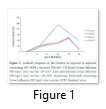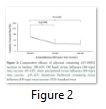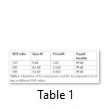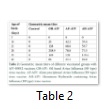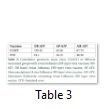Full Length Research Article
Comparative efficacy of different adjuvant containing inactivated vaccines against low-pathogenicity Avian Influenza H9N2 virus
Aayesha Riaz*,1, Muhammad Ali Shah1, Murtaz Ul Hasan1, Muhammad Yameen3, Mamoona Chaudhry2, Aafia Malik4, Muhammad Arif Zafar1, Saif Ur Rehman1, Ihsanullah Gawri1
Adv. life sci., vol. 4, no. 2, pp. 66-71, February 2017
*- Corresponding Author: Aayesha Riaz (Email: aayeshariaz@uaar.edu.pk)
Authors' Affiliations
2- Department of Epidemiology and Public Health, University of Veterinary and Animal Sciences, Lahore – Pakistan
3- Government College University, Faisalabad – Pakistan
4- Post graduate officer, Services Institute of Medical Sciences, Services Hospital Lahore – Pakistan
Abstract![]()
Introduction
Methods
Results
Discussion
References
Abstract
Background: Outbreaks of low-pathogenic Avian Influenza virus H9N2 (AIV-H9N2) occurred in poultry industry in Pakistan in 1998 and caused serious economic losses. Since then, many of the AIV-H9N2 vaccines have been introduced to Pakistani market to control the virus, however, it is still circulating all over the country. Therefore, the purpose of the study was to prepare and evaluate different adjuvant containing vaccines using local isolate of AIV-H9N2 in broiler birds.
Methods: Three vaccines; Alum precipitated (AP-AIV), Aluminum hydroxide gel (AH-AIV) and Oil based (OB-AIV) were prepared in the laboratory and injected into broiler birds at 7th and 14th day of age. There were four groups of birds including one control group. To evaluate the serological response of the birds to vaccines, serum antibody titers were measured using haemagglutination inhibition test (HI). Vaccinated and control birds were challenged with AIV-H9N2 and virus shedding was determined from trachea and cloacal swabs by HI.
Results: Out of the three prepared OB-AIV with hydrophile lypophile balance (HLB) values 5.37, 8.01 and 9.01, the vaccine with HLB value of 8.01 was the most stable. Each of the adjuvant containing vaccine was effective in inducing high HI antibody titers. However, OB-AIV was found to be the most effective in inducing a significantly higher (P<0.05) HI titer as compared to that of AP-AIV and AH-AIV each. No significant difference was observed between the HI titers induced by AP-AIV and AH-AIV. All the vaccines also showed effective protection against AIV-H9N2 challenge in vaccinated birds.
Conclusion: In conclusion, this study reports the successful preparation and evaluation of adjuvant containing inactivated AIV-H9N2 vaccines. OB-AIV formulation was found to be most effective to control the H9N2 virus infections in broiler birds.
Key words: Avian Influenza, Low Pathogenic H9N2, Vaccines, Adjuvant, Oil Based
Introduction
Avian Influenza (AI) is a viral infection of poultry. It has emerged as a disease with significant potential to cause extensive loses to commercial poultry production [1,2]. In 1998 an outbreak of unknown etiology was reported in heavily populated region in Mansehra and Abbotabad districts in Northern Pakistan. The causative agent was confirmed as AI virus (AIV) subtype H9N2 (AIV-H9N2) [3]. Later on other outbreak AIV-H9N2 in broilers and layers in Karachi and layers in Abbotabad were reported in 1998 and 1999. The morbidity was 100 percent and mortality was up to 50 percent [4]. Later on outbreaks of LPAI (H9N2) and highly pathogenic Influenza virus (HPIV) occurred in different parts of the country in different times [5-7]. The latest outbreak of LPAI (H9N2) has been reported in Pakistan in 2015 [4]. In recent years, due to the continuous rapid spread of H9N2 virus among domestic birds, it has gained significant importance [8-10]. This virus persists in chicks and spreads to non-affected flocks through fecal oral route without showing severe clinical signs [11]. Co-infection with other viruses like infectious bronchitis is one of the most important reasons for the high mortality resulted from H9N2 virus infection [4]. The emergence of this new subtype of AIV might be due to mutation or brought in this country by migratory birds. AIV are characterized by extreme variation in antigenicity. Minor changes in amino acid sequence of surface proteins can occur as a result of point mutation. The 8-segmented RNA of AIV is also a cause of this genetic re-assortment [1].
AI is a viral problem so it can only be controlled by bio-security measures or mass vaccination program. Effective vaccines are required for the protection against AIV. An effective vaccine depends not only on the presence of appropriate antigen, but also on the antigen delivery system i.e. the presence of adjuvants such as alum, microspheres, liposomes, immunostimulating complexes (ISCOM) or emulsions to stimulate and enhance the immune response against that pathogen [11]. Adjuvant increases the life and immunogenicity of a vaccine. AIV-H9N2 induced outbreaks are responsible for consternation to the poultry farmers. Effective and economical vaccines which can provide long term immunogenicity are the need of time. Therefore the present project was designed to prepare different adjuvant containing AIV-H9N2 vaccines and compare their efficacy in broilers.
Methods
Characterization of the virus
AIV-H9N2 virus was kindly provided by Olympia Laboratory Lahore and was inoculated in 9-days-old chicken embryo for the propagation via allantoic sac route. Allanto-amniotic fluid (AAF) and EID50 was calculated according to Reed and Muench method [12] and OIE manual [13]. AAF was harvested after 48 hours post inoculation (PI). The AIV-H9N2 suspension in the AAF was titrated using haemagglutination test (HA) as described by [14]. The virus was characterized by virus neutralization test and haemagglutination inhibition test (HI) using known serum against AIV-H9N2, AIV-H6N2 and AIV-H7N3, as described by [14]. The virus was inactivated by formalin (0.12%) at 37oC for 48 hours. The inactivation of the virus was confirmed by testing no HA activity after three blind passages in embryonated chicken eggs.
Vaccines preparation
Three vaccines; Alum precipitated AIV vaccine, Aluminum hydroxide gel AIV vaccine and Oil based AIV vaccine were prepared following the methods described by [15].
Alum precipitated AIV vaccine (AP-AIV)
The AAF (EID50 10-8.3) was admixed with aluminum potassium sulfate solution so as to have final 1g/kg concentration. The pH was adjusted to 7.4 and was incubated at room temperature for 24 hours.
Aluminum hydroxide gel AIV vaccine (AH-AIV)
AH-AIV was prepared by adding 250ml of 50g/l of aluminum sulfate solution into 100ml of 50g/l of sodium hydroxide solution whilst stirring vigorously. The white precipitate formed was centrifuged at 600xg. After washing twice with distilled water the compact pellet was re-suspended in 250ml of normal saline to form aluminum hydroxide gel. The gel was stored at 4oC. Equal volumes of AAF (EID50 10-8.3) was admixed with Aluminum hydroxide suspension.
Oil based AIV vaccine (OB-AIV)
OB-AIV was prepared according to hydrophile lypophile balance (HLB) values. The HLB values of the vaccines were fixed at 5, 8 and 9. These values helped in determining the amount of Span 80 and Tween 80 in the vaccine by using following formula [16].
Xa+Yb= HLB value for the vaccine
X= Amount of the Span 80 used in the oil base preparation
Y= Amount of Tween 80 used in the oil base preparation
A= HLB value of span 80= 4.3 (constant)
B= HLB value of Tween 80= 15 (constant)
By using above mentioned formula amounts Span 80 and Tween 80 were calculated for HLB 5.37, 8.01and 9.01. According to the calculated values three compositions of oil base were tried (Table 1).
The AAF (EID50 10-8.3) was admixed with oil base at 1:4 ratio. The vaccines were stored at 4oC for stability test.
Experimental plan for the vaccination study
In this experiment 60 broilers birds (one day old) were divided in to four groups; A, B, C and D (each group comprising 15 birds). The birds in groups A, B and C were vaccinated with OB-AIV, AP-AIV and AH-AIV respectively at 7th day of age. The birds of group B and C were boosted at 14th day of age with AP-AIV and AH-AIV respectively. Each vaccine was injected subcutaneously at dose rate of 0.5ml per bird (at the neck region), while birds of group D were kept as non-vaccinated control.
Experimental plan for the challenge study
Eight birds from each group were challenged at 30 days post vaccination. Each bird was inoculated by intra nasal route with 0.1 ml of AIV-H9N2 containing AAF (EID50 10-6). To determine virus shedding, tracheal and cloacal swabs were collected in nutrient broth at 2, 4 and 6 days post challenge. To reduce bacterial contamination, samples were treated with antibiotics. Each sample was inoculated to the 9 days old embryonated eggs via allantoic sac route to determine virus titer (EID50) using Reed and Muench method.
Collection of serum sample
Blood samples were collected from each bird on 5, 14, 21, 28, 35 and 42 days of age. The sera were isolated and stored in properly labeled plastic vial at -20oC till processing for HI test.
Haemagglutination Inhibition test
The HI antibody titer was determined following the method described by [14] by using 4 HA unit titer of inactivated virus in AAF. The HI titer of each sample was expressed as the highest dilution of serum showing inhibition of HA activity of the virus. Geometric mean titer (GMT), cumulative GMT (CGMT) and standard deviation (STD) of HI antibodies of each group was tabulated and compared as described by Villegas and Purchase [17].
The statistical significance of the data was determined by using Student's t test. Results were considered to be statistically significant if the comparison gave a P value of <0.05.
Results
Three different adjuvant containing AIV-H9N2 (EID50 10-8.3) vaccines when prepared and injected in broilers, induced neutralizing antibodies. The AP-AIV and AH-AIV induced higher levels of HI antibodies in the vaccinated birds when primed at 7th day of age and boosted the birds with the respective vaccine at 14th day of age. The antibodies reached to the peak level at the 4th-5th week of age, then started declining.
OB-AIV was prepared according to required HLB values of the oil base. It was observed that vaccine prepared with HLB value 8.05 was the most stable. In the vaccine prepared using HLB value 9.01, the liquid phase was separated at the top and oil phase at the bottom. While the vaccine prepared using HLB value 5.37, liquid phase was separated at the bottom and the milky white oily phase at the top. The birds vaccinated with OB-AIV showed high and consistent HI titer till 6th week of age (Table 2, Figure 1) as compared to birds of group B and CGMT induced by OB-AIV, AP-AIV and AH-AIV were 129.18+ 81.1, 67.74+ 40.5 and 63.56 +36.13 respectively (Table 3). The responses induced by OB-AIV was found significantly different (P<0.05) from that of AP-AIV and AH-AIV (Figure 2). However the antibody titers induced by AP-AIV and AH-AIV were not significantly different from each other.
To determine that birds were protected 30 days post vaccination 8 birds from each group were challenged with AIV-H9N2 (EID50 10-6). Birds from each vaccination group were found protected after challenge with virus as compared to control unvaccinated birds. No virus was recovered from the tracheal or cloacal swabs collected from the vaccinated birds, while virus was detected in all tracheal and cloacal swabs collected from the control unvaccinated birds.
Tables & Figures
Discussion
AIV- H9N2 virus is a low pathogenic influenza virus and cause severe economic losses to poultry farmers. H9N2 virus can pose a significant zoonotic threat like H5N1 [18-20]. Vaccination is the only preventive measure against the disease and effective vaccines are required for the protection against AIV. An effective vaccine depends not only on the presence of appropriate antigen, but also on the antigen delivery system. Most soluble proteins and peptides are weakly immunogenic and require the presence of adjuvants such as alum, microspheres, liposomes, ISCOM or emulsions to stimulate the relevant immune response [21]. To establish a long term memory response adjuvants are essential. Adjuvants enhance the immunogenicity when added in the vaccines. An antigen driven immune response is initiated when antigen is present and terminated once the antigen is eliminated. Non adjuvant containing inactivated AI vaccines are presumably absorbed from the inoculation site without providing a suitable stimulus to the immunocompetent cells [22].
In the present study the comparative efficacy of three different adjuvants containing AIV-H9N2 vaccines were determined. All the three vaccines have induced high antibody titers in chicken against AIV-H9H2. The purpose of incorporating adjuvants is to promote the immune response to the antigen of interest. Different studies have shown that adjuvant action results from a depot effect, due to which the duration of the interaction between cells and antigen is prolonged. Emulsion adjuvants has similar antigen releasing properties [21]. An emulsion is defined as a dispersion of two immiscible liquids in which one liquid which is called as dispersed phase is mixed into a second liquid which is called as continuous phase. In vaccine preparation, dispersed phase is water (antigenic media) and continuous phase is oil. In order to stabilize the emulsions, surfactants are added. Surfactants can be defined by their HLB value which gives information on their relative affinity for the both phases. HLB is an expression of relative simultaneous attraction of an emulsifier for water and oil [23]. Stability of a vaccine is very important and HLB is one of the various parameters which can influence on it. Different kind of emulsions can be formulated using different HLB values of the surfactant. Antigen release rate also varies widely among emulsions containing emulsifiers with different HLB values, hence it is very important to choose a suitable HLB value for preparation of a stable vaccine which can give a longer immunity by releasing antigen for a longer period of time [24].
In this study emulsion-type adjuvants containing vaccine; OB-AIV was prepared with different HLB values and HLB value 8.01 of the oil base was found the most stable. OB-AIV induced the highest levels of HI antibodies among the three vaccines used in the study (Table 2). Single dose of OB-AIV at the age of 7 days was found effective and induced high titers for longer period of time as compared to other two vaccines. AP-AIV or AH-AIV also induced higher levels of HI antibodies in vaccinated birds when primed at 7th day of age and boosted the birds with the same vaccine at 14th day of age (Table 2, Figure 1). The high levels of antibodies were detected till 4th -5th week of age. Stephenson et al found that two doses of inactivated vaccine given three weeks apart were safe and well tolerated. Antibody response to one dose of vaccine is poor so primed patients should be protected with single dose of same vaccine [25]. Yaqub et al used alum precipitated vaccine which could induce detectable levels of HI antibodies in vaccinated birds on 7th day post vaccination (PV) and did not display protection on 4th week PV [26]. In other study, Khan et al also found the same results with alum precipitated vaccine [27]. The birds which were vaccinated for only one time showed very low HI antibody titer as compared to those which were vaccinated two times after two weeks intervals. Aluminum hydroxide and other aluminum salts moderately enhance the antibody level [28].
The most preferable method to control AIV infection is the use of inactivated vaccines, worldwide [24-29]. This strategy not only provides long term immunity to the birds but also avoids the antigenic shift and/or drift in the virus genome which prevents genetic re-assortment [28, 29]. Adjuvants (oil based or non-oil based) containing vaccine when injected induced a depot at the inoculation site and cause irritation, recruit immune competent cells (lymphocytes) and antigen presenting cells (APC) at the injection site for a longer period of time [29]. As a result higher levels of antibodies titers can be achieved which is not in the case of non-adjuvant containing vaccine [30-33]. Upon challenge, with the AIV-H9N2, all the vaccinated birds were protected from infection which showed that adjuvant containing vaccines give protection for a longer period of time.
It is concluded from the experiment that adjuvant containing vaccines are effective in inducing high HI titers in broilers. Comparison of different adjuvant containing vaccines have shown that oil based vaccine was the highly efficient. The immune response produced in birds vaccinated with OB-AIV was significantly higher than other vaccines. The antibody titer induced by AP-AIV and AH-AIV were not significantly different from each other. In summary, the results of present study demonstrate that a protective immune response can be achieved by using H9N2 inactivated vaccines in broiler birds, suggesting that these vaccines could be used to prevent and control AIV-H9N2 in poultry industry. It is also suggested from the results of this study that a single dose of oil based AIV vaccine, at the early age of broiler birds, can be effective to prevent outbreaks of AIV-H9N2 for a longer period of time.
All authors contributed equally.
References
- Shane S. Avian Influenza. The current world situation; 1995. pp. 1-15.
- Alexander DJ. An overview of the epidemiology of avian influenza. Vaccine, (2007); 25(30): 5637-5644.
- Naeem K, Ullah A, Manvell R, Alexander D. Avian influenza: A subtype H9N2 in poultry in Pakistan. Veterinary Record, (1999); 145(19): 560-560.
- Muhammad K, I. Hussain, A. Riaz, R. Manzoor and M.A. Sajid Isolation and characterization of Avian influenza virus (H9 type) from the outbreaks of respiratory syndrome in commercial poultry. Pakistan Journal of Scientific Research, (2001); 533-4.
- Chaudhry M, Rashid HB, Thrusfield M, Welburn S, Bronsvoort BM. A Case-Control Study to Identify Risk Factors Associated with Avian Influenza Subtype H9N2 on Commercial Poultry Farms in Pakistan. PloS One, (2015); 10(3): e0119019.
- Iqbal M, Yaqub T, Reddy K, McCauley JW. Novel genotypes of H9N2 influenza A viruses isolated from poultry in Pakistan containing NS genes similar to highly pathogenic H7N3 and H5N1 viruses. PloS One, (2009); 4(6): e5788.
- Naeem K, Siddique N, Ayaz M, Jalalee M. Avian influenza in Pakistan: outbreaks of low-and high-pathogenicity avian influenza in Pakistan during 2003-2006. Avian Diseases, (2007); 51(s1): 189-193.
- Lee D-H, Song C-S. H9N2 avian influenza virus in Korea: evolution and vaccination. Clinical and Experimental Vaccine Research, (2013); 2(1): 26-33.
- Xu K, Li K, Smith G, Li J, Tai H, et al. Evolution and molecular epidemiology of H9N2 influenza A viruses from quail in southern China, 2000 to 2005. Journal of Virology, (2007); 81(6): 2635-2645.
- Xu K, Smith G, Bahl J, Duan L, Tai H, et al. The genesis and evolution of H9N2 influenza viruses in poultry from southern China, 2000 to 2005. Journal of Virology, (2007); 81(19): 10389-10401.
- Biswas PK, Christensen JP, Ahmed SS, Barua H, Das A, et al. Avian influenza outbreaks in chickens, Bangladesh. Emerging Infectious Diseases, (2008); 14(12): 1909.
- Reed LJ, Muench H. A simple method of estimating fifty per cent endpoints. American Journal of Epidemiology, (1938); 27(3): 493-497.
- Manual OT. Avian influenza. Manual of Diagnostic Tests and Vaccines for Terrestrial Animals, (2015). http://www.oie.int/fileadmin/Home/eng/Health_standards/tahm/2.03.04_AI.pdf
- Allan WH, Lancaster JE, Toth B (1978) Newcastle disease vaccines, their production and use. Food and Agriculture Organization of the United Nations.
- Brugh M, Beard C, Stone H. Immunization of chickens and turkeys against avian influenza with monovalent and polyvalent oil emulsion vaccines. American Journal of Veterinary Research, (1979); 40(2): 165-169.
- Stone HD. Optimization of hydrophile-lipophile balance for improved efficacy of Newcastle disease and avian influenza oil-emulsion vaccines. Avian Diseases, (1988); 68-73.
- Villegas P, Purchase, HG (1989) Titration of biological suspensions. In: Purchase HG, Arp, LH, Domermuth, CH, Pearson JE. A Laboratory Manual for the Isolation and Identification of Avian Pathogens. USA: Kendall/Hunt Publishing Company, USA. pp. 186-192.
- Ahad A, Rabbani M, Mahmood A, Kuthu ZH, Ahmad A, et al. Zoonosis update on H9N2 avian influenza virus. Pakistan Veterinary Journal, (2013); 33(3): 272-276.
- Nili H, Asasi K. Natural cases and an experimental study of H9N2 avian influenza in commercial broiler chickens of Iran. Avian Pathology, (2002); 31(3): 247-252.
- Rafique S, Siddique N, Qayyum M, Abbas MA, Ali A, et al. In Ovo Vaccination against Avian Influenza Virus Subtype H9N2. Pakistan Veterinary Journal, (2015); 35(3): 299-302.
- Yang Y-W, Wei A-C, Shen S-S. The immunogenicity-enhancing effect of emulsion vaccine adjuvants is independent of the dispersion type and antigen release rate—a revisit of the role of the hydrophile–lipophile balance (HLB) value. Vaccine, (2005); 23(20): 2665-2675.
- Tizard IR Veterinary immunology (2012). Elsevier Health Sciences.
- Lynch M, Griffin W. Food emulsions. Emulsions and Emulsion Technology, Surfactant Science Series, (1974); 6(1): 249-289.
- Aucouturier J, Dupuis L, Ganne V. Adjuvants designed for veterinary and human vaccines. Vaccine, (2001); 19(17): 2666-2672.
- Stephenson I, Nicholson KG, Glück R, Mischler R, Newman RW, et al. Safety and antigenicity of whole virus and subunit influenza A/Hong Kong/1073/99 (H9N2) vaccine in healthy adults: phase I randomised trial. The Lancet, (2003); 362(9400): 1959-1966.
- Yaqub T, Muhammad K, Rizvi A-U-R, Tariq M. Immune response of chickens to avian influenza vaccines. Pakistan Veterinary Journal, (1996); 1-6.
- Khan M, Das P, Chowdhury K, Islam M. Efficacy of alum precipitated fowl cholera vaccine in chicken. Bangladesh Veterinary Journal, (1994); 28(1): 25-30.
- Naim JO, Van Oss C, Wu W, Giese R, Nickerson P. Mechanisms of adjuvancy: I—metal oxides as adjuvants. Vaccine, (1997); 15(11): 1183-1193.
- Choi, YK, Ozaki H, Webby RJ, Webster R G, Peiris JS, et al. Continuing Evolution of H9N2 Influenza Viruses in Southeastern China. Journal of Virology, (2004); 78: 8609-8614.
- Unanue ER. Antigen-presenting function of the macrophage. Annual Review of Immunology, (1984); 2(1): 395-428.
- Shah MAA. DNA vaccines as sustainable Coccidiosis control strategies in chickens Science Letters, (2013); 1(1): 1-4.
- Mushtaq MH, Khattak I, Haqb N, Awan F. Mass Vaccination and Surveillance Reduced the Burden of Foot and Mouth Disease. Veterinaria, (2014); 2(2): 1-5
- Alam S, Khan S, Ahmed N, Rafiullah, Tahir F, et al. Comparative Efficacy of three Newcastle Disease Vaccine Strain in Layer. Veterinaria, (2016); 4(2): 6-12.


